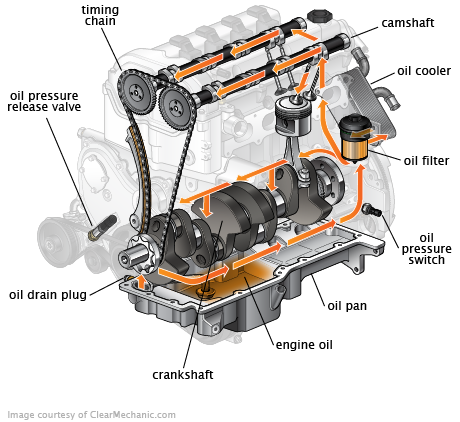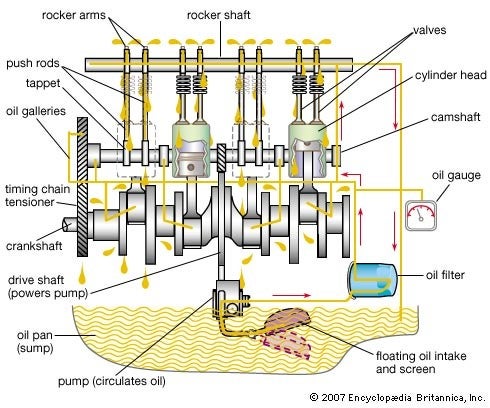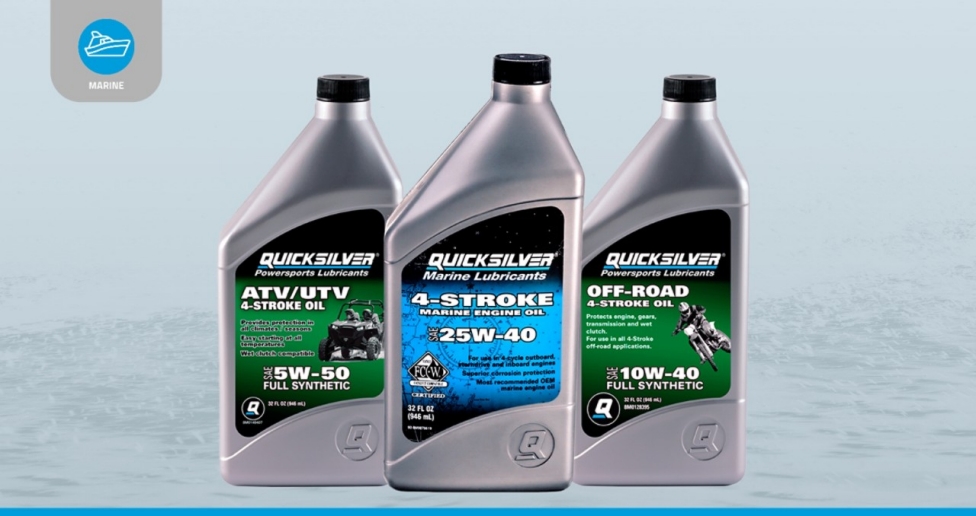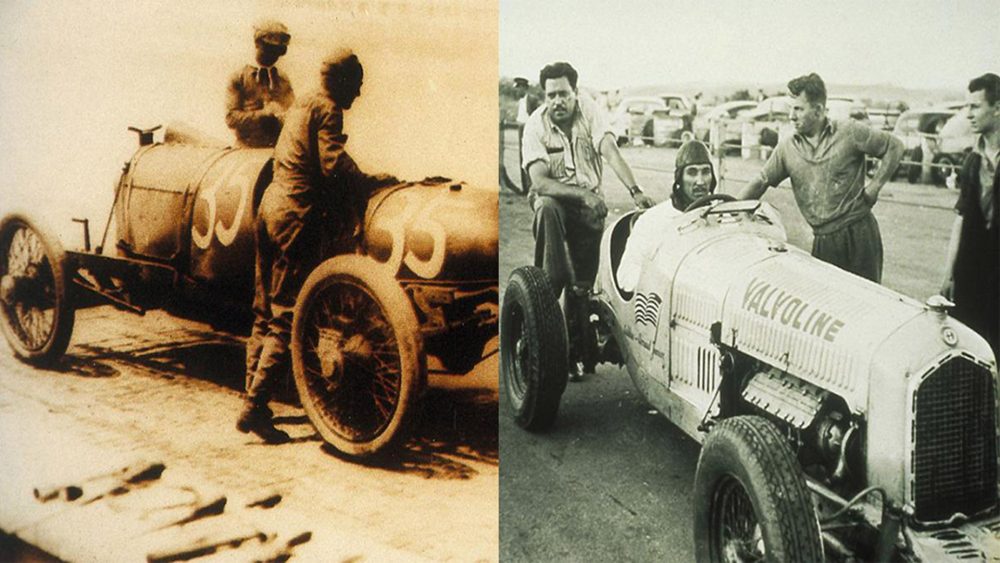Oil is forced into the space between the bearings and crankshaft journals in an engine. The majority of the oil is stored in the sump, and from there, it flows through the oil galleries, oil pump, and filter, before being pumped through the main bearings of the crankshaft, rod bearings, and oil lines to the cylinder head.
The oil is responsible for lubricating and cooling the engine components, ensuring they operate smoothly and efficiently. It is essential to check and top up the engine oil regularly, using the correct oil for your car, as low oil levels can lead to engine damage and reduced performance.

Credit: mannysmechanicalrepairs.com.au
The Journey Of Engine Oil
Engine oil goes on a crucial journey to ensure optimal performance. After being poured into the engine, it travels to the sump, which acts as its storage. The oil pump then sends it to the main and connecting rod bearings. From there, it flows through oil galleries, akin to veins, and reaches the cylinder head. This journey is vital for lubricating and cooling the engine components, ensuring smooth operation. The oil then returns to the sump to continue its cycle, providing essential lubrication to the engine. Understanding this path is essential for maintaining proper engine function and longevity.
Beneath The Hood
To fill up your oil, you first need to locate the oil filler cap in your engine bay. This should have the word ‘oil’ marked on it, or an outline of an oil can. Then, position your funnel at the top of the spout and pour your oil in. Make sure that you are using the correct oil for your car.
Oil is forced into the space between the bearings making contact with the crankshaft journals and the journals. The block has main bearings on the crankshaft, and connecting rods bearings are on the crank throws.
An engine’s lubrication system consists of a sump (where the bulk of oil is stored), oil galleries (just like veins that transport blood through your body), an oil pump (essentially the heart of the matter) and finally, the filter (like kidneys, this removes any impurities from the oil before it is pumped through the system).
The pump sends the oil up to the main bearings of the crankshaft (in the lower middle), which converts linear energy into rotational energy. From there, the oil moves through oil holes drilled in the crankshaft, to the rod bearings, and then through an oil line to the cylinder head (in the upper middle).
The Heart Of Lubrication
To fill up your oil, you first need to locate the oil filler cap in your engine bay. This should have the word ‘oil’ marked on it, or an outline of an oil can. Then, position your funnel at the top of the spout and pour your oil in. Make sure that you are using the correct oil for your car.
Oil is forced into the space between the bearings making contact with the crankshaft journals and the journals. The bearings are simple metal sleeves encircling the rotating components of the engine. The block has main bearings on the crankshaft, and connecting rods bearings are on the crank throws.
An engine’s lubrication system consists of a sump (where the bulk of oil is stored), oil galleries (just like veins that transport blood through your body), an oil pump (essentially the heart of the matter) and finally, the filter (like kidneys, this removes any impurities from the oil before it is pumped through the system).
The pump sends the oil up to the main bearings of the crankshaft (in the lower middle), which converts linear energy into rotational energy. From there, the oil moves through oil holes drilled in the crankshaft, to the rod bearings, and then through an oil line to the cylinder head (in the upper middle).

Credit: www.wolflubes.com
Main Bearings And Crankshaft Journals
Where Does Oil Go in Engine?
Main Bearings and Crankshaft Journals:
Oil is forced into the space between the bearings and the crankshaft journals. The bearings are metal sleeves encircling the rotating components of the engine. The main bearings are located on the crankshaft, while the connecting rod bearings are on the crank throws.
Supporting the Engine’s Core:
The oil’s role in reducing friction is crucial for the engine’s smooth operation. It lubricates the bearings, preventing metal-to-metal contact and minimizing wear. This ensures that the crankshaft, a vital component responsible for converting linear energy into rotational energy, can move freely and efficiently.
Oil’s Role in Reducing Friction:
The engine’s lubrication system consists of a sump where the bulk of the oil is stored, oil galleries that transport oil throughout the engine, an oil pump that circulates the oil, and a filter that removes impurities. The pump sends the oil to the main bearings of the crankshaft, through oil holes drilled in the crankshaft, to the rod bearings, and finally to the cylinder head.
Where Does Oil Flow in an Engine?
In summary, oil flows from the sump to the main bearings and crankshaft journals, ensuring smooth and efficient engine operation by reducing friction and preventing wear.
The Vital Oil Galleries
Oil in a car engine goes through a lubrication system consisting of a sump, oil galleries, an oil pump, and a filter. The oil is forced into the space between the bearings and the crankshaft journals, and then moves through oil holes drilled in the crankshaft to the rod bearings and cylinder head.
This ensures proper lubrication and function of the engine.
In an engine, oil is stored in a sump and transported through oil galleries, which are like veins that transport blood through the body. The oil pump acts as the heart of the engine’s lubrication system, pumping oil to the main bearings on the crankshaft and the connecting rod bearings on the crank throws. From there, the oil moves through oil holes drilled in the crankshaft to the cylinder head. The oil is forced into the space between the bearings making contact with the crankshaft journals and the journals. The bearings are simple metal sleeves encircling the rotating components of the engine. The oil also helps to cool engine parts and keeps them from wearing down too quickly. It is important to use the correct oil for your car and to regularly check and top up the engine oil level.The Sump: Oil’s Reservoir
Oil is a vital component of any engine, and it needs to be stored and recollected in a specific way. The sump is where the bulk of the oil is stored in the engine. It acts as the reservoir for oil and is located at the bottom of the engine. The oil pump is responsible for recollecting the oil from the sump and circulating it through the engine. The pump sends the oil up to the main bearings of the crankshaft, which converts linear energy into rotational energy. From there, the oil moves through oil holes drilled in the crankshaft to the rod bearings and then through an oil line to the cylinder head. The filter removes any impurities from the oil before it is pumped through the engine. To fill up your oil, you first need to locate the oil filler cap in your engine bay, which should have the word ‘oil’ marked on it or an outline of an oil can.
The Filtration Station
To fill up your oil, you first need to locate the oil filler cap in your engine bay. This should have the word ‘oil’ marked on it, or an outline of an oil can. Then, position your funnel at the top of the spout and pour your oil in. Make sure that you are using the correct oil for your car.
Oil is forced into the space between the bearings making contact with the crankshaft journals and the journals. The bearings are simple metal sleeves encircling the rotating components of the engine. The block has main bearings on the crankshaft, and connecting rods bearings are on the crank throws.
An engine’s lubrication system consists of a sump (where the bulk of oil is stored), oil galleries (just like veins that transport blood through your body), an oil pump (essentially the heart of the matter) and finally, the filter (like kidneys, this removes any impurities from the oil before it is pumped through the system).
The pump sends the oil up to the main bearings of the crankshaft (in the lower middle), which converts linear energy into rotational energy. From there, the oil moves through oil holes drilled in the crankshaft, to the rod bearings, and then through an oil line to the cylinder head (in the upper middle).

Credit: www.machinerylubrication.com
Monitoring And Maintenance
When it comes to monitoring and maintaining your engine’s oil, there are a few key steps to follow. One important aspect is checking the oil levels regularly. To do this, locate the oil filler cap in your engine bay and position a funnel at the top of the spout. Pour the correct oil into the funnel, making sure to use the right type for your car.
In terms of top-up techniques, oil is forced into the space between the bearings that make contact with the crankshaft journals. The bearings, which are simple metal sleeves encircling the rotating components of the engine, are located on the crankshaft and the crank throws. This ensures proper lubrication and smooth operation.
In an engine, oil is stored in the sump, which is the main storage area. The oil pump, similar to the heart, sends oil to the main bearings of the crankshaft, which then moves through oil holes drilled in the crankshaft. It then reaches the rod bearings and continues through an oil line to the cylinder head.
Understanding how oil circulates in an engine is crucial for maintaining its performance and longevity. By regularly checking oil levels and ensuring proper lubrication, you can keep your engine running smoothly.
Troubleshooting Common Issues
When dealing with low oil in your engine, it’s crucial to address contamination. Contaminated oil can lead to serious engine damage. It’s important to identify the source of contamination and take the necessary steps to address it. This might involve replacing faulty seals or gaskets, or repairing any damage to the engine. Regularly checking for oil leaks and addressing them promptly can help prevent contamination issues.
Advanced Engine Oil Dynamics
Oil in an engine is forced into the space between the bearings and the crankshaft journals. The main bearings on the crankshaft and connecting rod bearings on the crank throws are encircled by simple metal sleeves. An engine’s lubrication system includes a sump for oil storage, oil galleries for transportation, an oil pump as the heart of the system, and a filter to remove impurities. The pump sends oil to the main bearings and then through oil holes in the crankshaft to the rod bearings and the cylinder head. Temperature impacts the flow of oil, affecting its viscosity and pressure variations.
Choosing The Right Oil
To fill up your engine oil, you first need to locate the oil filler cap in your engine bay. This should have the word ‘oil’ marked on it, or an outline of an oil can. Then, position your funnel at the top of the spout and pour your oil in. Make sure that you are using the correct oil for your car.
Oil is forced into the space between the bearings making contact with the crankshaft journals and the journals. The bearings are simple metal sleeves encircling the rotating components of the engine. The block has main bearings on the crankshaft, and connecting rod bearings are on the crank throws.
An engine’s lubrication system consists of a sump (where the bulk of oil is stored), oil galleries (just like veins that transport blood through your body), an oil pump (essentially the heart of the matter) and finally, the filter (like kidneys, this removes any impurities from the oil before it is pumped through the sump).
The pump sends the oil up to the main bearings of the crankshaft, which converts linear energy into rotational energy. From there, the oil moves through oil holes drilled in the crankshaft, to the rod bearings, and then through an oil line to the cylinder head.
Environmental Considerations
When it comes to environmental considerations, recycling used oil is crucial for reducing waste and minimizing environmental impact. It’s important to dispose of used oil properly to prevent contamination and harm to the environment. Additionally, using eco-friendly oil options can further reduce the carbon footprint and promote sustainable practices. By choosing oils with renewable sources and biodegradable components, you can contribute to a healthier environment.
Frequently Asked Questions
Where Do I Put Oil In My Engine?
To add oil to your engine, locate the oil filler cap in your engine bay that should have the word ‘oil’ marked on it or an outline of an oil can. Position a funnel at the top of the spout and pour the oil in.
Ensure that you use the correct oil for your car. The oil circulates around the engine through oil galleries, an oil pump, and the filter, eventually arriving in the bottom oil pan or sump.
Where Does Oil In A Car Engine Go?
Oil in a car engine is forced between the bearings and crankshaft journals. It is stored in the sump, then pumped through the engine to lubricate and reduce friction. The oil system includes a pump, galleries, and a filter to keep the engine running smoothly.
Where Is Oil Stored In An Engine?
Oil in an engine is stored in the sump, which is the main storage area. From there, it is pumped through oil galleries to lubricate the various components of the engine, such as the bearings and crankshaft. The oil also flows through the oil filter to remove impurities before being circulated again.
Where Does Oil Flow In An Engine?
Oil flows from the oil pan to the oil pump, which sends it to the main bearings and then through the crankshaft. It also moves to the rod bearings and the cylinder head through various oil passages.
Conclusion
Understanding the path of engine oil is crucial for maintaining a healthy vehicle. From the oil filler cap to the sump, and through the oil pump and galleries, the oil circulates to lubricate and protect critical engine components. Proper oil maintenance is key to ensuring engine longevity and optimal performance.


